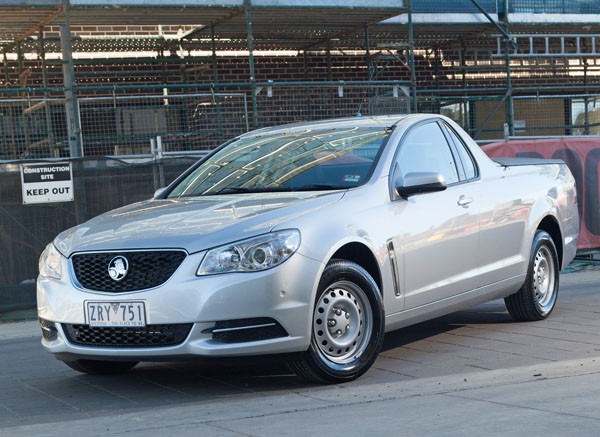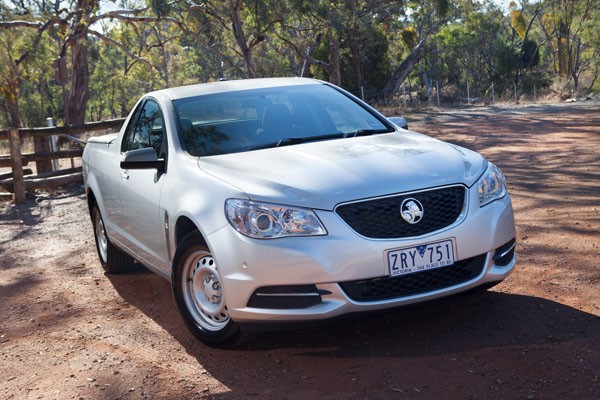Big and unashamedly bold in its shape the new Holden VF Commodore Ute is arguably the most sophisticated of its type ever sold in Australia.
Our test VF Ute wasn’t the usual upmarket, loaded-with-extras model we get from many car makers, but the ‘get down and dirty entry-level variant’, the Evoke. It used the 3.6-litre SIDI V6 engine with an automatic transmission, and had a manufacturer’s list price of just $32,990. That’s a hefty $2500 less than its predecessor the VE Commodore Ute on which it is heavily based.
The VF Commodore Evoke Ute comes standard with Auto Park Assist, front and rear parking sensors, reversing camera and remote vehicle start, the latter only installed in the automatic models.
STYLING
There has been some debate about whether the looks of the VF Commodore and Ute are different enough to the previous model. The VF Ute undeniably carries the Commodore DNA which accounts for this but there are enough changes to the front end to mark it out from its VE predecessor.
Most of these are to do with weight saving and improved aerodynamics, leading to increased fuel efficiencies. In times when we are used to high-design all round, the exterior appearance is somewhat let down by 16-inch steel wheels.
A completely new cabin design is built around the colour screen positioned at the centre of the dashboard. New technology on offer includes an electric park brake with automatic release and remote vehicle start.
Storage includes a deep centre console space with lid, plus back panel storage compartments behind the seats. However, a hair brush user complained of the difficulty in retrieving it from an over-slim door pocket.
Finally, there is what every ute should have: a standard high-density polyethylene liner for tub protection.
INFOTAINMENT
Like all new Holden VF Commodores, the new Ute has access via MyLink, the result of a partnership between General Motors and computer software giant Microsoft, enabling drivers to integrate their smart phone and stored media with their car.
Using the 8-inch full-colour touch screen situated at the centre of the dashboard, Bluetooth, USB and AUX functions can be manipulated, as well as controlling normal vehicle functions such as air-con and the like.
With a mobile device hooked up to MyLink, Pandora Internet Radio and Stitcher SmartRadio can be streamed through the system with drivers able to stream favourite radio stations as well as using the ‘thumbs up’ / ‘thumbs down’ buttons to tune their station preferences. They can also move to the next track via a steering wheel button or the touchscreen controls.
Via the Stitcher embedded app, drivers can choose from more than 15,000 news, comedy, sports and talk radio shows and podcasts from global broadcasters including NPR, CNN, Fox and the BBC. There’s a whole new world at the VF Ute occupants’ fingertips.
The system is less intrusive than average but is still likely to cause dangerous driver inattention from time to time.
ENGINE / TRANSMISSION
The base Ute is powered by Holden’s 3.6-litre SIDI V6 engine mated with a six-speed automatic transmission. Holden tell us this makes the engine up to 8.2 per cent more fuel efficient than the VE Commodore unit it replaces.
SAFETY
As well as improved structural integrity the VF range is backed up with active safety features such as electronic stability control with anti-lock braking, electronic brakeforce distribution, electronic brake assist and traction control. Added to these is Hill Start Assist for those tricky take-offs on inclines – the latter is unnecessary on automatics, but it makes a nice selling point.
DRIVING
The engine and transmission are backed up by a slightly lighter, more agile chassis for confident and predictable handling. We found there was less difference to ride and handling when it was empty or fully loaded than in many Holden utes in the past.
A monochrome Multi Function Display, a 3-inch LCD screen positioned in the centre of the instrument cluster, registers vehicle and trip information as well as warnings and messages, including a consumption trend meter consisting of a bar graph setting out how economically the vehicle is being driven over blocks of 50 kilometres.
Typically we used nine to twelve litres per 100 kilometres in the urban environment, coming down to seven to eight litres per 100 km on the motorway and in country driving.
The high positioned tray obscured rear vision to some extent, so the reversing sensors and reversing camera were well used. As has been a problem with the Holden VE Commodores for many years, the bulky A-pillar on the driver’s side shuts out part of the three-quarter view forward. Holden explains this is to achieve structural strength, but others do it better.
Despite all upgrades to the VF range, including extensive world-wide testing in sub-zero temperatures to desert heat, Holden still had enough slack to cut the prices of its VF Utes. Another bonus is capped price servicing which covers the first four standard scheduled log book services for the first three years or 60,000 km, whichever comes first.
SUMMING UP
Whether working hard in loaded situations or dressed up to make a statement in today’s trendy ute market, the new Holden VF Commodore Ute handles things nicely. And the price really is mouth-watering.
MODEL RANGE
3.6L SIDI V6 Ute: $32,990 (automatic)
3.6L SIDI V6 SV6 Ute: $32,990 (manual), $35,190 (automatic)
6.0L Gen IV V8 SS Ute: $38,990 (manual), $41,190 (automatic)
6.0L Gen IV V8 SS-V Ute: $42,490 (manual), $44,690 (automatic)
6.0L Gen IV V8 SS-V Redline Ute: $48,490 (manual), $50,690 (automatic)
Note: These prices do not include government or dealer delivery charges. Contact your local Holden dealer for drive-away prices.
SPECIFICATIONS (Holden Commodore Ute 3.6-litre two-door utility)
ENGINE
Capacity: 3564 cc
Configuration: 60-degree Double Overhead Cam V6 with four valves per cylinder. Twin knock control sensors with individual cylinder adaptive control. On-board diagnostics. Spark Ignition Direct Injection (SIDI). Continuously variable camshaft phasing for inlet and exhaust valves
Bore x Stroke: 94 mm x 85.6 mm
Compression Ratio: 11.5:1
Maximum Power: 210 kW @ 6700 rpm
Maximum Torque: 350 Nm @ 2800 rpm
Recommended fuel: 91 RON ULP. Note that using 95 RON (PULP) or higher may result in improved engine performance and efficiency. E85 can be used.
DRIVELINE:
Transmission: 6-speed automatic
DIMENSIONS, WEIGHT AND CAPACITIES:
Length: 5062 mm
Width: 1898 mm
Height: 1494 mm
Wheelbase: 3009 mm
Track: 1600 mm (front); 1614 mm (rear)
Kerb weight: 1656 kg
Fuel Tank Capacity: 71 litres
Towing Ability: 1600 kg (braked)
Turning circle (kerb to kerb): 11.6 m
SUSPENSION AND BRAKES:
Suspension: Direct acting stabiliser bar. Coil spring (front); multi-link Independent Rear Suspension (IRS). Coil spring. Stabiliser bar (rear)
Brakes: Four-wheel disc. Ventilated discs – front and rear. Twin piston alloy front calliper, single piston alloy rear calliper. Electronic stability control with Anti-Lock Braking System (ABS), Electronic Brakeforce Distribution (EBD), Electronic Brake Assist (EBA),Traction Control System (TCS).Hill Start Assist.
Steering: Electric assisted constant ratio rack-and-pinion steering
Wheels: 16 in x 7 in steel
Tyres: 225/60R16. Tyre sealant and air compressor kit
FUEL CONSUMPTION:
Type: 91 RON ULP. E85 compatible
Combined Cycle (ADR 81/01): 9 litres per 100 km. CO2 emissions 216 g / km
Emissions: Euro IV
GREEN VEHICLE GUIDE RATINGS:
Greenhouse Rating: 6 / 10
Air Pollution Rating: 8.5 / 10
STANDARD WARRANTY:
Three years / 100,000 kilometres










